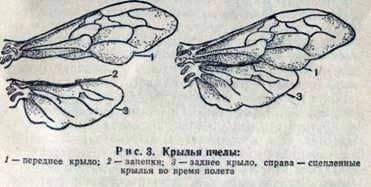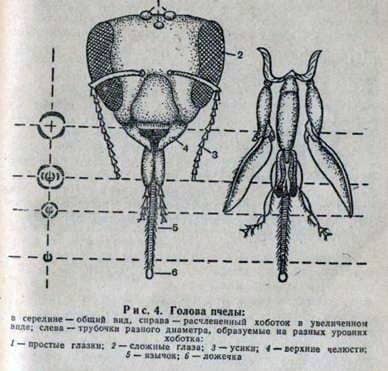Search for food by bees

The search and collection of food by bees are associated with their flights. The bee, devoid of wings, perishes. The bee has two pairs of well-developed wings; on each side of the body there is a large front wing and a somewhat smaller size-back. In the hive, both wings are separately folded on the back of the bee and do not interfere with its movement along the honeycomb and work in the cells.

During the flight, the front wing is engaged with the rear wing at the forward end of the rear wing there are 17-25 hooks with which the rear wing is engaged by a fold located at the corresponding place of the posterior edge of the forewing. Thanks to the clutch of the wings, they function as one unit during the flight. The wing consists of strong veins, between which stretched thin transparent membranes. This structure provides strength and lightness of the wing. To the bases of the wings are attached powerful muscles, located in the chest, which lead the wings into motion. In this case, thanks to the special joint of the wings with the breast, during the flight, the inclination of the wing plane changes: when the wings are raised, the bee’s body is maintained in the air (lifting effect), and when it is lowered, the bee advances (translational effect). Wings of the wing occur with such speed, that they can not be traced to the naked eye. Only with the help of high-speed filming found that a bee flying with a load, makes 250-300 strokes, and flying without a load – 180-200 strokes in 1 second. Intensively, bees harvest nectar within a radius of 2 km from the hive. A bee without a load flies at an average speed of 48 km per hour, with a cargo of 41 km per hour. When collecting nectar, the bee is in flight for about 1 hour, however the flight time varies greatly depending on the availability and the amount of nectar in the flowers.

The bee has five eyes: two large, complex, on the sides of the head and three small eyes in the middle of the forehead. With complex eyes, the bee is well oriented in flight; They are also adapted for a clear perception of objects at close range: in a flower, on a honeycomb, in a cell. Studies have shown that on a green background of grass and plant leaves, the bees easily distinguish between blue, blue, yellow, and white; the bee sees three separate colors in the ultraviolet spectrum (these colors are not distinguishable by humans), which is due to the wide spread of this color in nature. The majority of white petals for humans are perceived by bees as having distinctive shades and patterns. These drawings allow the bee to confidently distinguish the color of some white flowers from others. Bees clearly distinguish and the shapes of objects close to the petals of flowers that occur in nature. Forms of objects, not having for them biological value (a square, a triangle), they do not distinguish. The aroma of flowers guides the bees at a distance. The organs of the sense of smell are concentrated on the antennae (see Figure 4), where there are several hundred sensitive, olfactory cells (sensilla), allowing the bee to clearly distinguish smells, even with very strong dilution of the aromatic substance. Especially good bees perceive smells, having for them a biological value-honey, wax, worker bees, uterus. On the abdomen of the bee there are also special organs (pus glands), which release an aromatic substance, which orientates the bees upon swarming. allowing the bee to clearly distinguish smells even with very strong dilution of the aromatic substance. Especially good bees perceive smells, having for them a biological value-honey, wax, worker bees, uterus. On the abdomen of the bee there are also special organs (pus glands), which release an aromatic substance, which orientates the bees upon swarming. allowing the bee to clearly distinguish smells even with very strong dilution of the aromatic substance. Especially good bees perceive smells, having for them a biological value-honey, wax, worker bees, uterus. On the abdomen of the bee there are also special organs (pus glands), which release an aromatic substance, which orientates the bees upon swarming.
Search for food by bees
